Vatican Art Story | Location | Opening Hours Tickets | Authorisations
Art Story Sistine Chapel | Raphael | Caravaggio | da Vinci | Giotto | Titian | Veronese | Sculptures | Van Gogh |
Leonardo da Vinci “Saint Jerome in the Wilderness” at the Vatican Museums in Rome
Leonardo da Vinci “Saint Jerome in the Wilderness”
Painting - Oil and tempera on walnut wood (102.8 x 73.5 cm) 1480-1482Leonardo da Vinci's Technique Revealed in His “Saint Jerome in the Wilderness”
Therefore, this unfinished painting by Leonardo da Vinci is rich in information on his technique.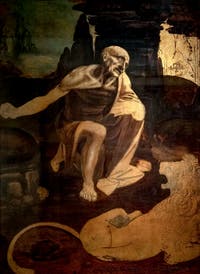
da Vinci Saint Jerome First, we note that there is no preparatory board and that he had drawn his Saint Jerome directly before starting to paint him.
An element that confirms the Florentine method of prioritising drawing in painting.
We also note that the colour was rubbed by Leonardo da Vinci in numerous places with the flat of his hand to obtain the famous “sfumato” effect found in his paintings.
The “Saint Jerome in the Wilderness” is thus an excellent example of Leonardo da Vinci's finger and hand painting.
The technique used by the artist is similar to that of Van Eyck for his Saint Barbara:
“By gently increasing both shade and colour, without impastation.
The white coating acts like a screen; the pictorial layer is always very transparent, the oil medium acts like a varnish, and the colours have the depth of lacquer.”
Serge Bramly “Leonardo da Vinci” Editions J.C. Lattès
Who was Saint Jerome, the famous author of The Vulgate, and what does he represent?
Saint Jerome (343-420) is one of the four great doctors of the Roman Church.Born in Veneto, in Stridon, he was baptised at 19 and ordained a priest at 29.
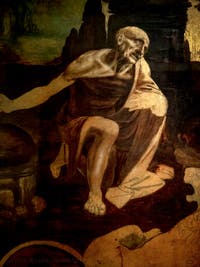
da Vinci Saint Jerome Jerome went to the Holy Land to lead an old-fashioned life like Saint Paul of Thebes, whose “Life” he wrote.
Returning to Rome, he was the secretary of Pope Damasus I for three years; then, he left for Bethlehem to create a community of hermits and translate the Bible into Latin.
His considerable work was perfectly successful since its translation, called “Vulgate”, was proclaimed the official version of the Catholic Bible in the 16th century.
While a hermit in the desert, he said he had heard the trumpets of the Last Judgment there.
But he was also obsessed with the thoughts of young girls he had known in Rome.
Saint Jerome described his asceticism in the desert as follows:
“While I only had scorpions and wild beasts as companions, I often found myself in my mind in congregations of young girls, and in my cold body, in my already dead flesh, the fire of debauchery was still burning with me.”
“I remember that days and nights were one and that I didn't stop hitting my chest until the Lord gave me peace.”
Saint Jerome
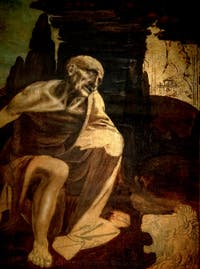
da Vinci Saint Jerome He fought against temptation by exerting extreme asceticism on himself, which is why he has often been represented as half-naked, hitting his chest with a rock.
He is often portrayed accompanied by a lion, as in Leonardo da Vinci's painting.
A presence that initially corresponded to the history of Saint-Gerasmus and was then attributed to Saint Jerome due to a homophony error.
According to the legend of Saint Gerasimus, which became Saint Jerome’s, while he was in the desert, a lion came to him limping because of a thorn stuck in the pad of one of his legs.
Saint Jerome would then have rid him of them, and the lion, grateful, would not have left him.
Leonardo da Vinci's “Saint Jerome in the Wilderness”
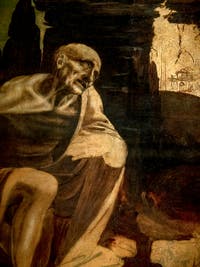
da Vinci Saint Jerome Leonardo da Vinci chose to show us a Saint Jerome in whole suffering.
He is on his knees, half-naked, emaciated, clutching a rock in his right hand, ready to hit himself while his face is turned to the sky, his eyes almost repulsed.
His suffering intensity can be seen in the features of his extremely hollow face, almost without flesh, on the verge of asceticism.
The anatomical studies carried out by Leonardo da Vinci are obvious here: no error in representing the various muscles, tendons, etc., up to his protruding ribs.
The intensity of the saint's suffering is strikingly realistic.
The use of brown and white intensifies the discharge effect: with his cheeks hollowed out and his eyes deep in his eye sockets, you can feel Saint Jerome at the end of his strength, barely still able to beat his chest with the rock he squeezes in his fist.
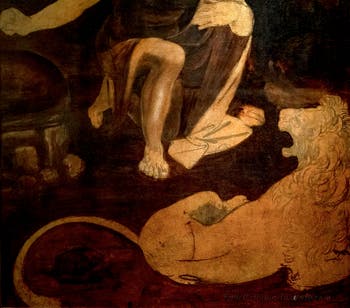
da Vinci Saint Jerome There is a darker area on the saint's chest, with Leonardo da Vinci suggesting here the wounded spot where Saint Jerome hit himself with his stone.
To amplify his degree of penance, Leonardo da Vinci also represented Saint Jerome in a rocky, arid desert, a metaphor for the emaciated body of the saint himself.
The realism of the lion by “Saint Jerome in the Wilderness”
Leonardo da Vinci's lion is undoubtedly one of the most realistic that can be found in the painting of the period. You can even say that it is perfect.This was thanks to the Medici, who owned a zoo populated by numerous African animal species, including a giraffe.
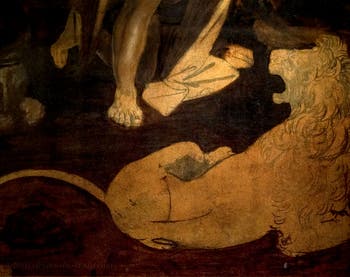
da Vinci Saint Jerome Leonardo da Vinci thus had the privilege of seeing a living lion and drawing inspiration from it for his painting.
A roaring lion whose open mouth echoes the cry of distress that can be seen escaping from Saint Jerome's mouth.
The animal looks at the saint, who himself looks at the sketch of the crucified Jesus.
We also notice the design of a church. Some people saw the facade of the Santa Maria Novella church in Florence.
One cannot but admire the genius of Leonardo da Vinci in this painting, full of power and emotion, which, although incomplete in most parts, perfectly reflects the torment of Saint Jerome.
Art Story Sistine Chapel | Raphael | Caravaggio | da Vinci | Giotto | Titian | Veronese | Sculptures | Van Gogh |
Vatican Art Story | Location | Opening Hours Tickets | Authorisations
Back to Top of Page

